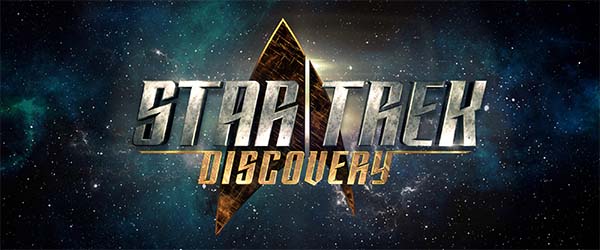
There's still a lot that we don't know about CBS's upcoming Star Trek series for its All Access streaming service. Early information and rumor was that the show would be run by Bryan Fuller (who formerly worked on the Deep Space Nine writing staff), that he had hired Nicholas Meyer (former director of The Wrath of Khan and The Undiscovered Country) to be the show's principle writer, and that the show might be a seasonal anthology series that would take place between the events of The Undiscovered Country and The Next Generation At least some of this information may be incorrect.
Earlier this year, the first teaser trailer was released. It also was not very forthcoming with specific information, but there were a few details that could be inferred.
The first teaser showed little detail, but seemed to imply a confirmation of a seasonal anthology.
The trailer begins in space over earth, but then warps away to exotic locations across space before revealing the show's logo and the tagline "New crews. New villains. New heroes. New worlds.". My interpretation of this teaser (assuming that there's an interpretation to be had) is that it is intended to show us that this new series will be shifting its attention away from Earth and out into deep space. That is promising.
The tagline definitely seems to support the idea of a seasonal anthology, since everything is plural. Granted, it could be a single storyline that just focuses on multiple ships' crews in parallel, but I hope that this is intended to verify that the show is a seasonal anthology in which each new season will be a completely independent, self-contained storyline separate from the previous season(s). However, Bryan Fuller himself has gone on the record as saying that the show is not an anthology series. Instead, he says that the show will "tell a Star Trek story in a modern way". By this, he means that each episode in a season will be a chapter of a larger story. This isn't entirely new to Star Trek, since both Deep Space Nine and Enterprise already had season-long arcs. But even then, those shows were still heavily episodic, with most episodes telling self-contained stories that can be enjoyed on their own without relying on having seen the previous episodes. Not so in this new series. Much like Game of Thrones, Walking Dead, Battlestar Galactica, and so forth, this new Star Trek series will likely require that its audience see every episode, in proper order, to be able to understand what's happening.
A few weeks ago, at Comic Con, we got something a little more concrete... [More]
974cbef6-843a-4ed8-87cb-1916bef03c83|0|.0
Tags:Star Trek, Star Trek: Discovery, CBS, all access, Bryan Fuller, Nicholas Meyer, anthology, seasonal anthology, science fiction, U.S.S. Discovery, Ralph McQuarrie, Star Trek: the Motion Picture, prequel, Star Trek: Phase II
My past two blog posts have been focused on open world gaming. These posts have been continuations of an earlier post about the narrative "limbo" that many open world games create via their quest structures. In the first post in this second series, I pointed out what I perceive to be a problem with open world games that insist on turning their sandbox worlds into little more than convoluted mission-select screens and collectible checklists. In the following post, I described some games that I think managed to make successful open worlds by including features or mechanics that made traveling through the space (or knowledge of the space) into a meaningful mechanic. This time, I want to go back to some of the games that I singled-out in the first post in this series, and brainstorm some ways that they could have made better use of the large spaces that their maps offered so that traveling around the world wouldn't become so boring later in the game.
But before I do that, I want to re-emphasize that I don't hate these games. They're just not very good at using their space, and that's what I'm criticizing. Well, the newer Assassin's Creed games have been pretty terrible. Anyway, I pick on games like Skyrim and The Witcher III a lot, but I like them just fine - I bought the DLC for both. I pick on them, not because I hate them, but because I do like them and I want them to get better (or for their sequels to get better). Rather, my objective here is to find ways for these games to make better use of the large, open spaces that they provide the player, so that exploring the map feels more mechanically relevant, more interesting, or more rewarding; and to feel less like a time-sink.
Games like Skyrim and The Witcher III have massive worlds, but do a poor job of utilizing the space.
Bethesda's Skyrim and Fallout titles, as well as CD Projeckt Red's Witcher III and Rockstar's Grand Theft Auto V, already have open worlds that transcend being simple, convoluted mission-select screens like games like Assassin's Creed and Metal Gear Solid V. They populate their worlds with little narrative world-building details that make their worlds feel alive and lived-in (even though they may feel stagnant). So what could a game like Skyrim or The Witcher III have done to improve its open world? [More]
1a284324-86e6-4bf6-90a4-dca665c348d9|1|5.0
Tags:open world, sandbox, game design, road trip, map, traversal, travel, cartography, geography, narrative, ludonarrative, ludonarrative dissonance, limbo, paradox, Kafkaesque, quest, Ubisoft, Bethesda, Rockstar Games, Beenox, Insomniac Games, Naughty Dog, Assassin's Creed, The Elder Scrolls, Skyrim, The Witcher 3, Grand Theft Auto, Grand Theft Auto V, The Last of Us, Spider-Man, web-swinging, comic book
Last time, I discussed what I perceive as a problem in the way that most open world games (specifically, sandbox games) design their maps and use the space that the maps offer - or fail to use that space, to be more specific. So many open world maps end up feeling less like actually playing the game, and more like a convoluted mission-select and collectible checklist screens. This problem is especially bad in the Ubisoft model of design, and is also a problem (to a lesser extent) in Bethesda's open worlds. Due to the popularity of these developers' franchises, many other developers have been cloning these styles of games to one extent or the other, to the point at which Ubisoft's open world model seems to be the go-to template for any developer trying to make an open world game. These games aren't necessarily bad. They just aren't very good at making the space of their maps feel meaningful in its own right.
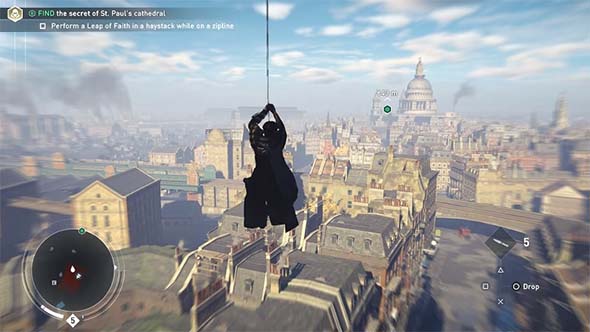
Many open world games have large, expansive maps that mostly feel empty and pointless,
as the player rushes through them simply to get to the next map marker or checklist item.
But now that I've established what I see as a problem, I want to focus on positive feedback. In this discussion, I'm going to look at a handful of games that should serve as inspirations for would-be open world developers. Ironically, some of these games aren't even open world games, but they still pose valuable lessons for how games that are open world could better use their game spaces. That isn't to say that the games discussed here are perfect. In fact, many of them have their own major flaws. But each of them has some element of design that utilizes the actual game map as a component of active play, rather than just a space in which game sequences exist. First, let's take a look at a game that was re-made recently, and use it as a "before and after" case study of map design... [More]
75d0658b-0278-43f3-a9e5-d3df3d01939d|4|4.3
Tags:open world, map, traversal, travel, cartography, geography, narrative, ludonarrative, ludonarrative dissonance, quest, vehicle, driving, racing, exploration, wasteland, survival, resources, Ubisoft, Bethesda, Resident Evil, Metal Gear Solid V: the Phantom Pain, Assassin's Creed, The Elder Scrolls, Skyrim, The Witcher 3, Grand Theft Auto, Grand Theft Auto V, Grand Theft Auto: San Andreas, Shadow of Mordor, Fallout, Fallout: New Vegas, Wasteland 2, Mad Max, Miasmata, Assassin's Creed IV: Black Flag, Burnout: Paradise, Shadow of the Colossus, Dark Souls
I wrote a lengthy blog late last year about the stagnant, "limbo"-like feel of most open world games' narratives. I had written that blog mostly before I played Metal Gear Solid V, and so I wasn't able to incorporate my thoughts regarding that game into the blog. But I did come to a new realization about open world gaming while I was playing MGSV. In my review of that game, I noted that:
"Even the open world itself feels constrained, as sheer cliffs prevent you from travelling too far off of the roads and serve to functionally railroad the player towards the small set-piece outposts and villages."
- from my Metal Gear Solid V: the Phantom Pain review
I realized while playing MGSV that the game had built this large, open world (well, two large, open worlds really, but I hadn't gotten that far yet), but it didn't really care to let the player actually traverse that space or use it in any meaningful way other than scavenger hunting for collectibles. At least those collectibles felt relevant to gameplay though! Roughly half the map is dead space that the player can't even access. There was also this strange focus on using the helicopter to drop in and drop out of missions, rather than actually living in the game world, as the character had to do in Snake Eater. The map started to feel less and less like a place, and more like a convoluted mission-select screen. At first, this seemed like a strange, isolated example of an open world game that really doesn't want the player actually exploring its world. But as I thought about it, I realized that this isn't really a new phenomenon; it's actually just a very extreme example of what has become a sort of defacto state in most open world games.
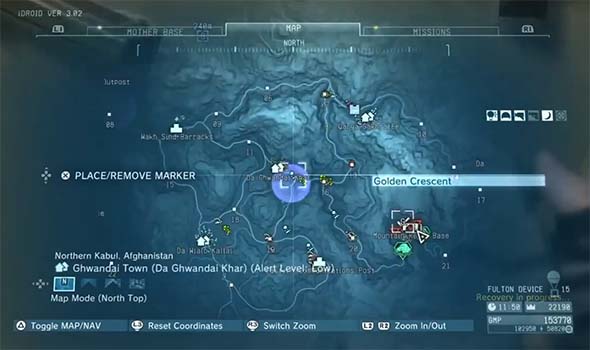
The Afghanistan map of Metal Gear Solid V feels heavily constrained by sheer cliffs.
Think about it this way: in a linear game with rooms and corridors, every hallway and room should serve some purpose or function. In most games, this function will be some kind of skill or system mastery test. An action game like Devil May Cry will throw enemies at you to fight; a puzzle game like Portal will have a puzzle (or a piece of a puzzle) in the room to solve; a stealth game like Metal Gear Solid 3 will have a sneaking challenge or obstacle to pass; and so on. In the best games, each of these challenges will also provide a unique or novel test of skill or system mastery: unique combinations of enemies, unique puzzles, or novel arrangements of enemies and obstacles. Other games can use those rooms for thematic or narrative purposes. A survival horror game like Resident Evil or Silent Hill will usually put enemies, puzzle items, or supplies in a room, but some rooms might instead contain a scripted scare. In some cases, a room might even be left completely empty in order to build some kind of tension or anticipation, or to delay the release of already-built tension or anticipation.
So what is the gameplay purpose of an open world map? ... [More]
d6e62cdb-b171-437a-b1a7-107859c9c818|4|4.5
Tags:open world, sandbox, game design, map, paradox, traversal, travel, cartography, geography, narrative, ludonarrative, ludonarrative dissonance, quest, exploration, driving, racing, vehicle, Ubisoft, Bethesda, Beenox, Metal Gear Solid V: the Phantom Pain, Assassin's Creed, the Amazing Spider-Man, Spider-Man, web-swinging, The Elder Scrolls, Skyrim, The Witcher 3, Fallout, Mad Max, Far Cry
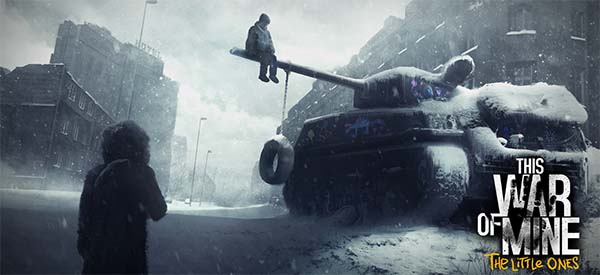
It was a long wait to get this DLC on PC and Steam. It originally released back in January on consoles, while we early adopters of the PC version were stuck waiting out in the cold with no clue whether or not we'd ever get the expansion. I wanted to play it, but I was hoping that a PC version would be released because I was skeptical that controlling a shelter full of characters with only an analog stick (and no pause button) would be unweildy. But it finally did get a release on Steam, and was even discounted during the Steam Summer Sale, so there was no way that I was going to pass that up.
The base version of This War of Mine is a fantastic game and ranks up there with Papers, Please, Metal Gear Solid 3, and Ace Combat 4 as one of the best games about war that I've ever played. This War of Mine is a very harsh, brutal, and depressing game. But if you didn't think that it was a depressing enough game to begin with, then wait till you play it with children as playable characters! The expansion adds some new scenarios with child characters as well as a handful of child-specific craftable items, but it's surprisingly skimpy on new content. As far as I can tell, there are no new scavenge locations, ambient events, or neighbor events.
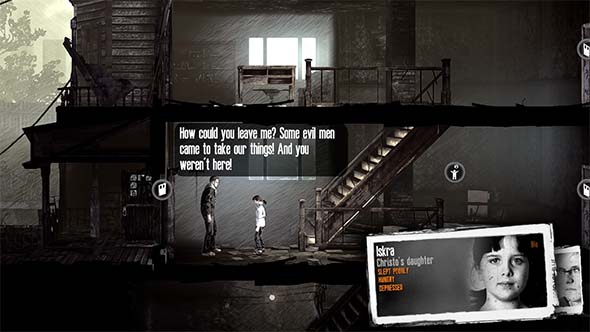
If the game wasn't already difficult and depressing enough, now you have to keep children safe as well.
The trauma of war
Children can be both a burden and a blessing in this game. By default, they can't perform most crafting, they can't shovel away rubble or unlock blocked doors, they can't be sent out to scavenge at night, and they can't do anything to guard or protect the shelter from raids. At the start, they are basically just extra mouths to feed that have the potential to consume more of your valuable medicines and bandages, but they can't contribute directly to your survival. They can also be particularly needy, and their needs can be tough to meet as you struggle just to get the basics like food, water, and an assembly line of crafting stations.
However, it won't stay like this for long, as children can be taught to do many of the same crafting tasks that the adults can do... [More]
7f046816-2d50-4dbe-8958-7c140325ddb6|0|.0
Tags:This War of Mine, This War of Mine: the Little Ones, expansion, DLC, PC, Steam, 11-bit studio, indie gaming, strategy, children, family, war, siege, refugee, civilian, survival, rogue
|

| 12 | | | | | | | 60 | | 11 | | | | | | | 55 | | 10 | | | | | | | 50 | | 09 | | | | | | | 45 | | 08 | | | | | | | 40 | | 07 | | | | | | | 35 | | 06 | | | | | | | 30 | | 05 | | | | | | | 25 | | 04 | | | | | | | 20 | | 03 | | | | | | | 15 | | 02 | | | | | | | 10 | | 01 | | | | | | | 05 |
|